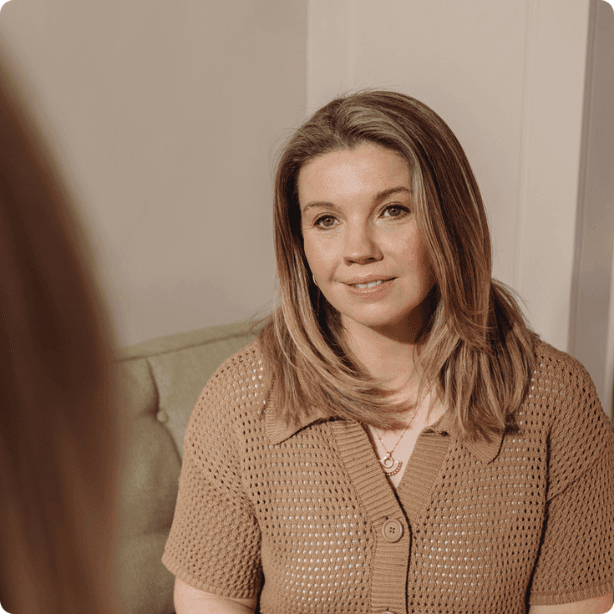Testosterone is a natural female hormone, just like oestrogen and progesterone. Levels are usually highest between the ages of 18 and 24. Our levels decline steadily with age and may be up to 70% lower by the time of natural menopause.
Many women will not notice the reduction in testosterone levels over time and will have no need to replace this hormone. However, it can be the final missing piece of the jigsaw in menopause management for some and appears to be especially important in women with premature ovarian insufficiency (POI), early menopause and/or surgical menopause (removal of ovaries).
What is testosterone?
Testosterone is a natural androgen (sex) hormone. In males, it plays a key role in the development and maintenance of sex characteristics and functions including deepening of the voice, libido and the stimulation of sperm production.
Women also need testosterone but at much lower levels. It is produced in the body by your ovaries and adrenal glands, as well as other tissues and cells. It plays a role in women’s:
- Libido (sex drive)
- Sexual arousal and response
- Mood
- Energy levels
- Bone and muscle health
- Cardiovascular health
- Cognitive performance
- Menstrual cycle
- Fertility
Testosterone levels in menopause
Testosterone levels usually reach their peak in your early 20s. They begin to decline in your 30s and by the time you reach menopause, levels can have reduced significantly.
If you have your ovaries removed (oophorectomy) or an operation or treatment that impacts your ovarian function, you can experience a more sudden and drastic drop in hormones than would naturally occur as the ovaries are responsible for producing around half of a woman’s testosterone.
Aside from age and surgical menopause, there are other causes for reduced testosterone including:
- Turner syndrome (a genetic condition where the ovaries don’t develop)
- Pituitary gland tumour
- Radiation
- Chemotherapy
- Addison’s disease (where the body doesn’t produce enough of certain hormones)
- Ovarian insufficiency
- Malnutrition (due to anorexia, for example)
- Hyperprolactinemia (too much of the hormone prolactin)
- Hypothalamic amenorrhea (the loss of periods due to extreme weight loss, exercise or stress)
Certain medications can also lower testosterone. These include:
- Hormonal contraceptives
- Corticosteroids
- Antiandrogen medications
- Oral oestrogen
- Opioids
Symptoms of low testosterone in menopause
A blood test is the only way to confirm that your testosterone levels are low. However, low testosterone levels can lead to a variety of symptoms including:
- Low sex drive
- Decreased sexual satisfaction
- A lack of energy or feeling tired
- Vaginal dryness
- Mood changes, including depression and anxiety
- Hair thinning
- Dry, brittle skin
- Loss of muscle strength and tone
- Sleep issues, such as insomnia and disrupted sleep
Should you take testosterone for menopause?
Many women with low testosterone do not experience any symptoms, including loss of libido. There’s usually no need to address low testosterone levels unless symptoms are impacting your life and well-being.
It’s also not usually recommended in routine clinical practice for testosterone to be used on its own to treat menopausal symptoms. The British Menopause Society advises that testosterone replacement in menopause can be considered should oestrogen alone fail to improve low libido and it can be used safely alongside hormone replacement therapy (HRT). Some women may also gain improvement in mental sharpness, energy levels, musculoskeletal strength and joie de vivre, but there is not enough evidence for testosterone to be formally recommended for these reasons in current guidelines.
Prior to starting testosterone replacement, low levels should be confirmed with a blood test. Blood levels will then need to be monitored at 3-6 months and then yearly after this. This is to ensure that testosterone levels stay within the normal female physiological range and reduce the risk of side effects.
Side effects and risks of testosterone replacement
Many women who use testosterone experience no side effects as the dose prescribed replenishes the levels of the hormone in the body. However, like with any medication, there is a possibility of side effects including:
- Skin irritation at the application site
- Increased hair growth at the application site
- Acne
- Change in mood
- Deepening of the voice
- Enlarged clitoris
- Androgenic alopecia (hair loss)
There is limited research on how safe or effective testosterone replacement therapy is for long-term use, but studies are currently being conducted on its use to treat menopause symptoms.
Benefits of testosterone replacement in menopause
The primary use for testosterone replacement is to treat low libido/ sexual desire in women. It isn’t usually prescribed for other reasons and randomised clinical trials of testosterone to date have not demonstrated the beneficial effects of testosterone therapy for cognition, mood, energy or musculoskeletal health.
However, some women find that taking testosterone as part of their HRT regimen brings about additional benefits than when just using oestrogen. Benefits may include:
- Increased sex drive
- Improved sexual arousal and pleasure
- Increased energy and stamina
- Increased muscle mass and strength
- Improved mood
- Higher focus and mental clarity
- Better sleep
- Weight loss
- Improved self-image
Can a GP prescribe testosterone for menopause?
Currently, there is no testosterone product available on the NHS licensed for female use or to treat menopause symptoms. However, a specialist doctor may be able to prescribe it for you.
Male-licensed products, such as Testogel, can be used off licence in accordance with British Menopause Society guidelines. Alternatively, we can prescribe Androfeme testosterone cream privately. This is a body-identical female licensed testosterone cream which is imported under a special licence from Australia.
Types of testosterone replacement for menopause
Most testosterone products come as a cream or gel that is rubbed into the skin daily (transdermal preparations). They are very well tolerated and thought to be low risk. If used at the recommended doses, and with appropriate blood monitoring, side effects are minimal. Higher doses can sometimes lead to unwanted effects such as local hair growth at the application site, mild acne, and hair loss. These effects can be avoided/minimised with appropriate monitoring. Other people can experience side effects if they have skin-to-skin contact with testosterone gel or cream so it’s important that you let it dry completely before coming into contact with others.
In exceptional circumstances, some women may be given testosterone via an implant, but these are not readily available across the UK (whether on the NHS or privately). Implants are usually reserved for younger women in surgical menopause who have not achieved any benefit from transdermal preparations.
If you are experiencing low libido and other symptoms, it might be a good idea to talk to someone who understands what you’re going through. If you’re already on HRT, we can review your medications and evaluate whether introducing testosterone replacement may be beneficial. If you are yet to start HRT, we can recommend a treatment plan based on your personal circumstances, symptoms and needs. To get started, book a consultation with one of our Menopause Care specialists.





